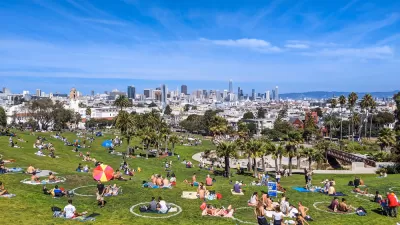The Census Bureau released new data on May 27 that includes the first four months of the pandemic. Seattle tops the growth rate at 2.2% from July 1, 2019, to July 1, 2020, while Baltimore and San Francisco land at the bottom with -1.4%.

Gene Balk, The Seattle Times' FYI Guy, delved into the excel spreadsheets accessible in the Census Bureau's May 27 release, "New Vintage 2020 Population Estimates Available for Cities and Towns..." His column includes two charts: the five fastest-growing cities from July 1, 2019, to July 1, 2020, and the five cities that had the highest rates of population loss. Fifteen of the fifty largest cities (30%) saw their populations decline during this time period.
Throughout the pandemic, we’ve been reading stories about people fleeing big cities for the suburbs, smaller towns, and rural areas. And, of course, here in Seattle, a lot of folks have talked about our city dying.
Yet the Emerald City outpaced its sunbelt counterparts. "Fort Worth, Texas, ranks No. 2, followed by Mesa, Arizona; Austin; and Tampa." Even more remarkable, Balk notes that Seattle's growth rate was even higher than the preceding year, 2018 to 2019, and also the fastest-growing city of the past decade.
Population losses
California dominates the bottom five, with San Francisco (-1.4%), San Jose (-1.3%) and Long Beach (-0.8%). Los Angeles was also among the 15 large cities that lost population (-0.3%). However, Sacramento, Oakland, Fresno, and San Diego eked out small gains.
Note that more recent, year-end 2020 population estimates are available from the California Department of Finance (posted here).
Biggest numerical losers
After Baltimore, San Francisco, and San Jose, New York City saw the highest rate of population loss (-0.8%), seeing a decrease of almost 90,000 people.
Wendell Cox also reported on the new census data, making these observations on the Big Apple for New Geography:
With 8,253,000 residents in 2020, the city of New York had its lowest annual reported population since 2010. Its 90,000 loss in 2019-2020 was the greatest sustained during the decade, while its gain over the entire decade was only 61,000. According to the Census Bureau estimates, New York’s population had peaked at 8,469,000 in 2016 and fallen by more than 200,000 over the past four years.
Chicago saw the second greatest loss, almost 14,000 people (-0.5%). It remains the third most populous city with almost 2.68 million, after Los Angeles with 3.97 million.
Tips on the data
"The figures published May 27 by the Census Bureau are part of the agency’s annual population estimates, and are not from last year’s official every-decade population count," notes John Egan at the end of his report on the data and how it relates to America's second-fastest-growing large city for CultureMap Fort Worth. He adds:
Meanwhile, the populations of Dallas and Houston barely budged from 2019 to 2020. Each city saw its population grow by less than 1 percent, with Dallas’ population inching up by just 74 people and Houston’s by only 400. On July 1, 2020, Dallas’ population was 1,343,266 and Houston’s was 2,316,120 [fourth largest city after Chicago], according to the Census Bureau estimates.
Balk of The Seattle Times notes that "[t]he Census Bureau data doesn’t include any of the components of population change."
In other words, we can’t see how much of Seattle’s growth was due to in-migration vs. out-migration, and we don’t know how many moved to the city from within Washington, from other states, or from other countries. The data also doesn’t show “natural growth” numbers — births vs. deaths.
That makes it a little tricky to understand how Seattle bucked the trend and had a healthy growth rate during the pandemic — or, to be specific, through the early months of the pandemic. If there was a turnaround in Seattle’s population growth after July 1, this data wouldn’t capture it.
Speaking of the pandemic
It can't go unsaid that Seattle was the original epicenter of the pandemic before it shifted to the New York metropolitan area. Unlike New York, In Seattle, the city, King County, and the state government were credited with handling the health emergency well from the onset.
Adding to the pandemic enigma of Seattle's growth spurt, Balk notes that the fastest growing city in Washington last year was the Seattle suburb of Kirkland (2.6%), the site of the first deadly coronavirus cluster in the United States.
More on Seattle from Gene Balk in Planetizen:
- Office Demand in Seattle Suddenly Back and Bigger Than Ever, May 10, 2021
- Seattle Leads the Nation in Reducing Car Ownership, November 4, 2019
- Where Demographic Trends Tilt More White in Seattle, September 20, 2019
- A Little Baby Boom in Seattle, April 16, 2019
- New Levels of Car Dependence Follow Seattle's Growth, August 10, 2017
- Waking Up to Seattle's New Density, February 9, 2016
FULL STORY: Surprise! Seattle was the fastest-growing big U.S. city in 2020

Alabama: Trump Terminates Settlements for Black Communities Harmed By Raw Sewage
Trump deemed the landmark civil rights agreement “illegal DEI and environmental justice policy.”

Planetizen Federal Action Tracker
A weekly monitor of how Trump’s orders and actions are impacting planners and planning in America.

The 120 Year Old Tiny Home Villages That Sheltered San Francisco’s Earthquake Refugees
More than a century ago, San Francisco mobilized to house thousands of residents displaced by the 1906 earthquake. Could their strategy offer a model for the present?

LA’s Tree Emergency Goes Beyond Vandalism
After a vandal destroyed dozens of downtown LA trees, Mayor Karen Bass vowed to replace them. Days later, she slashed the city’s tree budget.

Sacramento Leads Nation With Bus-Mounted Bike Lane Enforcement Cameras
The city is the first to use its bus-mounted traffic enforcement system to cite drivers who park or drive in bike lanes.

Seattle Voters Approve Social Housing Referendum
Voters approved a corporate tax to fund the city’s housing authority despite an opposition campaign funded by Amazon and Microsoft.
Urban Design for Planners 1: Software Tools
This six-course series explores essential urban design concepts using open source software and equips planners with the tools they need to participate fully in the urban design process.
Planning for Universal Design
Learn the tools for implementing Universal Design in planning regulations.
Ada County Highway District
Clanton & Associates, Inc.
Jessamine County Fiscal Court
Institute for Housing and Urban Development Studies (IHS)
City of Grandview
Harvard GSD Executive Education
Toledo-Lucas County Plan Commissions
Salt Lake City
NYU Wagner Graduate School of Public Service




























